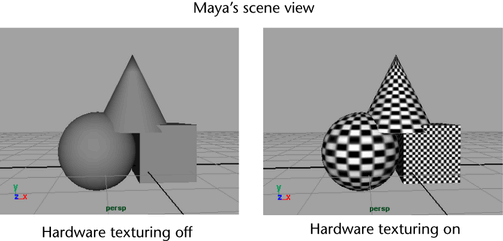Hardware texturing, a Maya
feature that you can easily turn on or off, lets you to see approximations
textures, lights and objects in your scene in a scene view.
What you see depends
directly on the settings you make in the
Render Settings window and
per-object settings you change. What you see is not necessarily
what appears in the final render, but it gives you a good idea.
NoteIf you are using
a file texture that uses MirrorUV and the resolution of the hardware
rendered texture in the scene view appears degraded, use the following
environment variable:
MAYA_HW_FILE_TEXTURE_RESOLUTION_OVERRIDE
To see textures, lights, and objects
in a view port
- In the scene view, select Shading
> Smooth Shade All.
- Select Shading > Hardware
Texturing (or press the hotkey 6).
- Do any of the following (optional):
- To use all lights in the scene, select Lighting
> Use All Lights (or press the hotkey 7).
- To see a more accurate preview result
(which may take a little longer), adjust the Hardware
Texturing attributes in the object’s material’s Attribute
Editor.
NoteWhen you play an
animation with just
Hardware Texturing turned on,
each of the necessary file textures are read in one at a time and
the animation speed is choppy.
Use Interactive
Sequence Caching Options to load file textures into memory only
once for faster interactive animation (but this uses a lot of memory).
